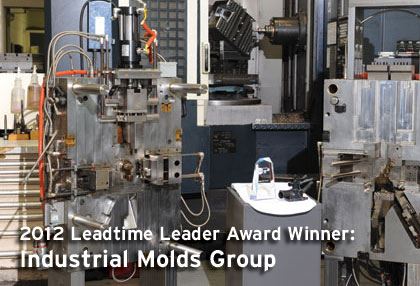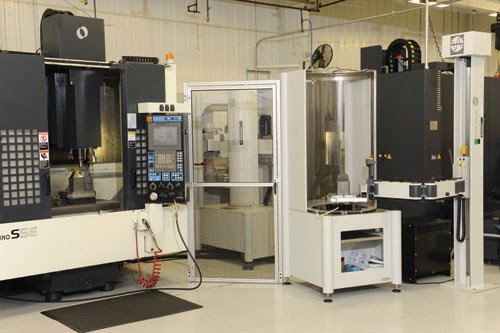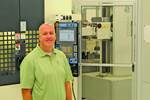2012 Leadtime Leader Awards: Industrial Molds Group
Extensive investment in equipment, technology and its employees coupled with an innovative approach to its mold manufacturing process has earned this mold manufacturer the MoldMaking Technology 2012 Leadtime Leader Award.
Industrial Molds Group’s (Rockford, IL) diverse offerings encompass the design, engineer and build of injection molds with complex geometries that range from single-cavity to 32-cavity high-volume molds; mold repair; prototypes and engineering changes (ECOs); MoldFlow analysis; and mold sampling and qualification. The company also has built quite a reputation for itself in the automotive industry as the provider of complex parts for Tier 1 and Tier 2 automotive suppliers.
The 55-employee company credits the addition of a Makino F-5 CNC high-speed machining center that completes the company’s hard-milling robotics cell—which also has an S56 Makino high-speed machining center—as a major factor in its eight-week average leadtime on projects.
Also serving the industrial, commercial appliance, medical, lawn and garden and packaging markets, Industrial Molds manufactures two-shot, insert and unscrewing molds. According to Industrial Molds Vice President Tim Peterson, the company’s business philosophy is based on service. “Our primary goal is to provide the best service possible, meeting our customers’ requirements with innovative, creative approaches that solve their manufacturing challenges,” he explains. We work every day to improve in every area possible from the front door to the production floor. We seek to provide a stable working environment for our team members, and offer them challenging work to increase job satisfaction in a team environment.”
Founded by Tim’s father Jack Peterson in 1968, the company was built on the philosophy that thinking outside the box, creativity and hard work were the keys to success, Peterson notes. Thus, in the late 90s, the company started to transition to a team-oriented approach in design engineering and mold development to shorten leadtimes, improve quality and meet customer requirements for faster time-to-market. “At that time we added our first automated machine for carbon,” he comments. “In 2002 we became ISO certified and have maintained our certification since that time.
We also added five-axis carbon cutting with a robot and two EDMs with a robot—equipped with Erowa’s job management system—to provide greater production efficiencies throughout the shop. Over the past three years, Industrial Molds has invested more than $1 million dollars in the latest state-of-the-art high-speed machining, EDM equipment and software. We have also invested in hiring and training the best moldmakers available.” Tim’s brother Eric serves as Operations Manager and John Kuntze is the CFO.
In addition, Industrial Molds realizes a similar investment must be made in its employees. “Any company can buy equipment, but it is the creativity of our engineers, the innovative thinking of our mold designers, and the precision skills of our machinists and moldmakers that make the difference—that put us on the cutting edge,” Peterson emphasizes. To that end, the company has a fully staffed Engineering Technology Center that provides state-of-the-art CAD/CAM software to provide product development assistance and ensure manufacturability of every component to optimize molding and produce parts in a cost-effective manner, Peterson adds.
To maintain its stringent leadtimes, the company relies on a combination of its ISO system and Lean Manufacturing principles. “With automation technology we schedule work so that the processes that take a long time we do unattended at nights and on weekends,” says Peterson. Industrial Molds also has the capability to cut graphite in the high-speed mill as well, which also helps fill the gap at night. The company’s automation implementation extends to the Quality Control department with a pallet receiver on the Brown and Sharpe Coordinate Measuring Machine (CMM). “The former process involved burning one set of electrodes, then probe for dimensional accuracy,” Peterson says. “We use the CMM to control the process.”
Industrial has reduced its average leadtimes by 50 percent over the last five years thanks to the aforementioned investments in equipment/technology and employees. “Other things that are giving us the ROI today are directly related to better training, understanding what the machinery and equipment can do and learning to optimize every piece of equipment we have,” Peterson says. “We discovered that even though we had the right machinery and equipment, we needed a quality system to help us with the production challenges. Our speed is directly correlated with the information we get—accurate information is key. When a mold project is released to us, a whole team of six or seven different departments becomes involved. The most difficult part of the mold build is the designing loop. We’ve been able to compact that down with early collaboration with the customer, and performing MoldFlow analysis to get it right from the start. We also invested in Windchill software (ptc.com) for better transfer of information.”
The company uses an outside marketing/PR consultant to develop press releases as well as a monthly newsletter that is sent to its database of customers and potential customers. Industrial also attends trade shows and has added a salesperson with great contacts in the medical market, an area in which the company is trying to grow more business.
“We value the diversification of the skills of our team members, and try to maximize these skills in various areas of our business,” Peterson concludes. “We always try to think outside the box on every new project that comes in. While some companies take a part design and make the mold that makes the part, we always try to optimize the mold and the molding process that we feel can help our customer get better productivity and efficiency, and reduce costs.”
Related Content
Dynamic Tool Corporation – Creating the Team to Move Moldmaking Into the Future
For 40+ years, Dynamic Tool Corp. has offered precision tooling, emphasizing education, mentoring and innovation. The company is committed to excellence, integrity, safety and customer service, as well as inspiring growth and quality in manufacturing.
Read MoreConfronting the Mold Design Talent Drought
Recently, I reposted on LinkedIn the results of an informal survey we conducted, which revealed a shortage of skilled mold designers. It quickly gained a lot of traction. Given the response, I thought I'd summarize the feedback and keep the conversation going.
Read MoreMMT Chats: 5 in 5 with Best Tool and Engineering
MoldMaking Technology Editorial Director Christina Fuges reveals 5 best practices for improving efficiencies within shops...in 5 minutes. Our guest is Joe Cherluck, President of Best Tool and Engineering in Clinton Township, Michigan.
Read MoreMaking Mentoring Work | MMT Chat Part 2
Three of the TK Mold and Engineering team in Romeo, Michigan join me for Part 2 of this MMT Chat on mentorship by sharing how the AMBA’s Meet a Mentor Program works, lessons learned (and applied) and the way your shop can join this effort.
Read MoreRead Next
Automation Investment Yields Speed and Flexibility
In 2004, Industrial Molds Group took the first steps toward integrating automation to reduce both costs and turnaround times.
Read MoreAre You a Moldmaker Considering 3D Printing? Consider the 3D Printing Workshop at NPE2024
Presentations will cover 3D printing for mold tooling, material innovation, product development, bridge production and full-scale, high-volume additive manufacturing.
Read MoreHow to Use Strategic Planning Tools, Data to Manage the Human Side of Business
Q&A with Marion Wells, MMT EAB member and founder of Human Asset Management.
Read More
























